#bryozoan colony
Text
AAH this is such a hard question haha

Thanks so much for asking @insectsinthestars ! I felt like this required some photos!
I truly do not think I have a favorite, I tried to pick one but I could not. I love them all so much. Here are a few that mean the most to me though!
This blob of Bryozoans! This one is special to me because it is a chunk of just pure Bryozoans, it is actually super light and REALLY delicate. Every time I set it down, it sheds some particles. The fact that this survived the elements for potentially hundreds of millions of years makes my heart tighten up.
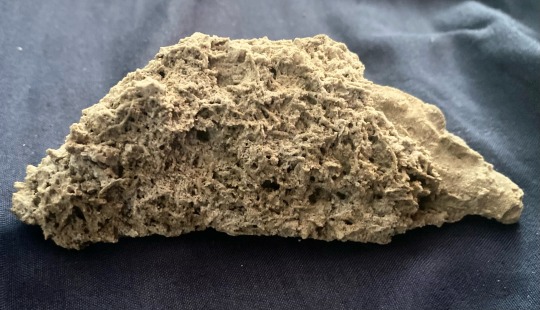

These are also the largest branches I have found, by far! (Bryozoa are tiny tiny animals that live in colonies, similar to coral)
Of course, I have to include my ONE trilobite haha. Yeah, that was a good day. I kinda love that it is just his little booty, hehe. Maybe one day I will work up the courage to attempt to chisel the rest of it out, I just reallllly do not wanna damage it. But yea.. man, do i cherish it
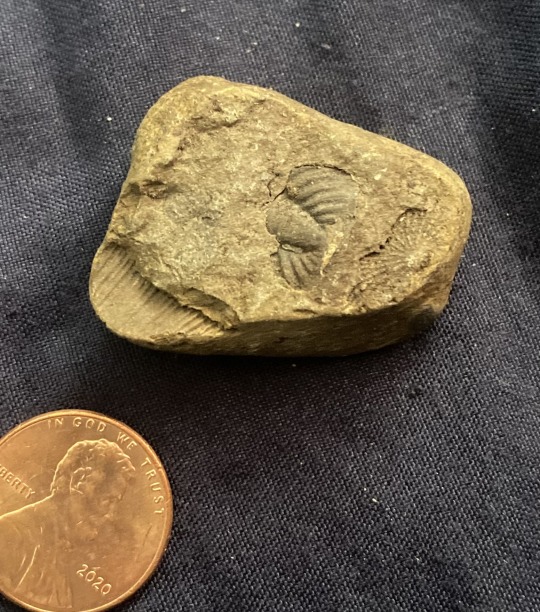
And I would honestly feel bad not including any Brachiopods, since they make up 80% of my fossils. But again, I really can’t choose a favorite:( I have a lot and I love them all. So these one’s are from the very beginning of my fossil hunting days (2019) and I can still remember finding them and crying in the woods :’)


#devonian period#my fossils#bryozoan colony#bryozoa#bryozoans#trilobite#trilobites#devonian fossils#devonian fossil#devonian#fossilblr#rockblr#fossils#fossil#amateur paleontology#paleontology#brachiopods#brachiopod#rocks#geology#earth science#natural science#nature#fossil hunting#fossil collecting
19 notes
·
View notes
Text
do you ever think about how weird it is that deer convergently evolved bones with the same sort of fractal branching pattern seen in like. trees. and coral and bryozoan colonies. and absolutely nothing similar to deer
Like it's a popular shape, but deer got there through the most roundabout way imaginable, evolving special mineralized organs for use in ritual combat that literally fall off and regrow like the leaves of deciduous plants. It's part of their endoskeleton, they grow in with skin on them and everything, but the deer rub off the skin so they can use the exposed bone as Sharp Dangerous Weapon
2K notes
·
View notes
Text
Phylum Round 1

Mollusca: Snails, slugs, cephalopods, bivalves, chitons, limpets, and others. This group contains the largest invertebrates, the giant and colossal squids. They are the largest marine phylum, but many members are terrestrial. Although they are incredibly diverse in body shape, all Molluscs generally have a hard "radula" used for eating, a mantle that may secrete a hard shell, and a body mostly composed of dense muscle. These animals can be predators, herbivores, filter feeders, symbiotic, and even parasitic. This phylum exhibits remarkable diversity overall.
Bryozoa: Moss Animals. Small, frequently colonial, and often colorful, Bryozoans are found in both freshwater and marine habitats. Their crown of tentacles are used for filter feeding, similar to Entoprocta. Colonies consist of zooids living within small cup-like supports that fuse together, forming encrusting or branching structures. Individuals may take on different shapes for different roles within the colony, such as the "avicularia", which are bird-beak-shaped zooids used for defense.
#mollusca#bryozoa#animal bracket#tumblr bracket#bracket tournament#poll bracket#phylum round 1#phylum
143 notes
·
View notes
Text
Phylum #22: Entoprocta, the goblet worms!

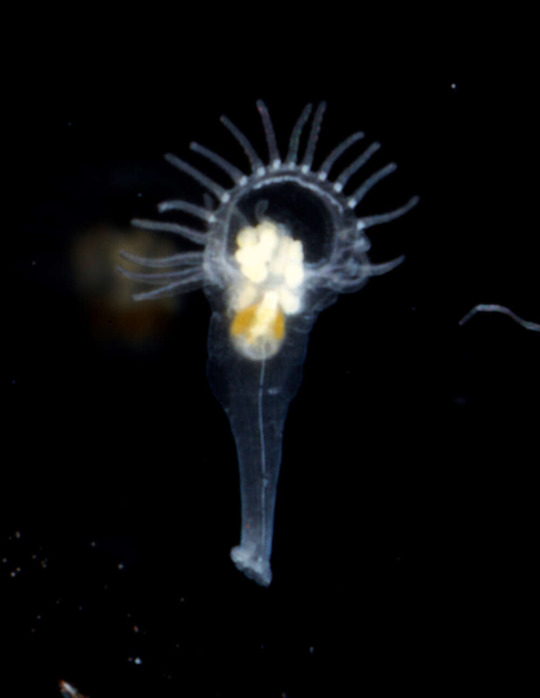
Despite their looks, these are not sea anemones, crinoids or bryozoans - these creatures have in fact been found to be mollusks' closest relatives! Although this part of the tree of life is in flux, entoproctan larva share the peculiar nervous system of mollusks, leading researchers to unite both in a single clade!
Entoproctans or kamptozoans, often referred to as goblets due to their stalked cup-like form, have a much simpler body plan than their relatives. A crown of tentacles at the top of the cup beats to bring a current through the U-shaped gut inside, passively filtering food particles. And that's it!
Goblets often live in massive colonies, with new ones budding from the stalks of previously-established ones. These stalks actually serve a triple function, also extending the reach and allowing them to share nutrients. However, a few species are free-living and solitary, crawling with their foot (their equivalent of the stalk), hitching a ride on other animals, or even jumping over!
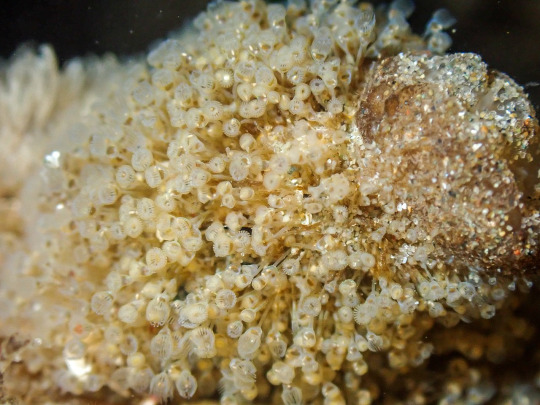
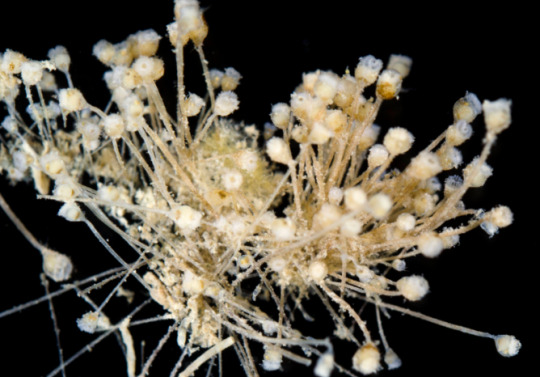
#forms and phyla#entoprocta#kamptozoa#goblet worms#goblets#tetraneuralia#marine biology#marine life#and this tag will make sense much later#bryozoa
81 notes
·
View notes
Note
I’ve heard of siphonophores before but when I looked up what they were I didn’t really get it ( ´ ▽ ` ;;) Since you really like them I was wondering if you’d wanna talk about them to me? I really wanna know what they are cuz they sound cool but if you don’t want to then that’s ok too /gen /lh
(also hello ^^)
hello!!! :D
i'd love to tell you about siphonophores!!!! they're my favorite marine animals, and i'm happy someone else is interested too!!!! i'm no marine biologist, but i'll be happy to share what i know and understand from tons of internet-surfing.
so, a small intro to the siphonophores!
siphonophores are part of the cnidarian group, which includes jellyfish, anemone, hydras, and corals. the cnidarian group is mostly composed of animals with tentacles or projections that sting. siphonophores live in the pelagic zone, meaning they inhabit the entire water column of the open ocean.
the best part about these guys is that they aren't really a single organism. they're comprised of many, many singular individuals called zooids! zooids can either be polyps or medusae.
zooids, as per the merriam-webster dictionary, are defined as:
one of the asexually produced individuals of a compound organism (such as a bryozoan, siphonophore, or coral colony)
(https://www.merriam-webster.com/dictionary/zooid)
zooids are lil guys which specialize in different tasks to manage... well, all the other zooids.
some zooids manage certain basic functions that make the other zooids thrive. they all have different names, categories, and functions, and this diagram, although simple, captures it beautifully!
fun fact: all zooids are genetically identical, since they come from the same embryo!
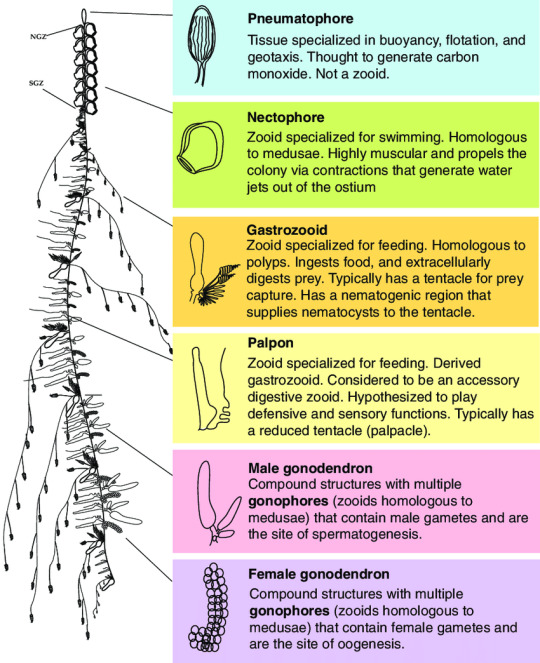
if any zooid were to hypothetically separate from its colony, then it would cease to function.
let's take a separated palpon, for example. the palpon would not be able to survive for long because its only purpose is to manage the food, but there's no other zooid to support its any other basic function. most separated zooids cannot survive alone.
that is because a palpon cannot swim and reproduce; a gonodendron cannot eat or swim; and the pneumatophore cannot reproduce or eat.
if you want to see siphonophores in action, a fantastic video by the Monterey Bay Aquarium Research Institute does just that! it has to be one of my favorite videos on the tube <33
there's also a video by the Octopus Lady, a marine youtuber, which goes over what i talked about in more detail! it's a great watch, and it was my introduction to this current obsession-
further reading + sources:
......and that's it!
thank you for asking me!!! biology is my passion, and i love seeing other people getting interested in it, too! i hope your day goes well, and that your curiosity is satisfied! i'm honored to have an opportunity to talk about these biological wonders!
#asks#siphonophore#marine biology#cnidaria#cnidarians#biology#science#deep sea#marine life#marine animals#sea life
3 notes
·
View notes
Note
Oooh, are you colonial zooid? If so, what kind??
I mostly know about the ones from class Hydrozoa (with animals such as the flower hat jelly, man whores, and blue buttons) or tunicates (like Salps and Pyrosomes), but I know there are a lot more out there, hehe :)
wouldn't say I'm really a zoon (or any individual zooid, for that matter), just an appreciator of creatures C{≡≡≡ <- makeshift jelly since i don't have the emojis yet :P
will say that i started this blog after learning about siphonophores, and by extension hydrozoans as a whole, though! they're still the ones I'm most familiar with, but i do also know of corals, tunicates, and bryozoans (but not much about them, unfortunately!)
(while we're on the topic: don't tell anyone, but my favorite cnidarians are actually myxozoans—just find it neat that they subvert the more elaborate = "more evolved" idea, and that one of these guys are the only multicellular organism to not aerobically respirate!)
🌊🌊 thanks for dropping by! little thingie for you down below the waters 🌊🌊
Drew an upside-down jelly since they're neat and there aren't any zoa on there :]
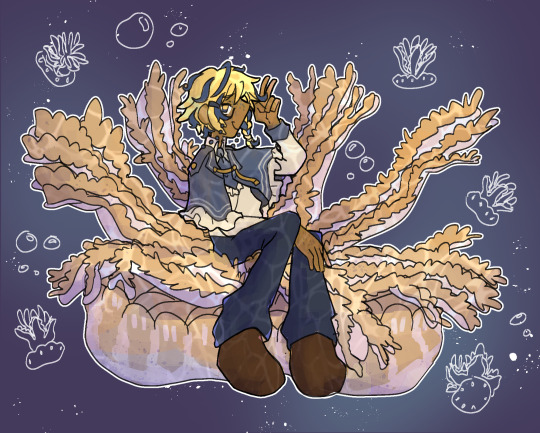
5 notes
·
View notes
Note
Hi! So stoked that you found some cool fossils!! Im a paleontologist and just wanted to give you some more info on what you have! Hopefully this is welcome information and not redundant! Mixed in with the brachiopods in your second picture theres a kind of elongate column which is a crinoid! its a kind of echinoderm (related to sea urchins and sea stars) that is still alive today! And from your pictures the last mystery fossil is probably a bryozoan, a colonial filter feeding organism that is also still alive today! I would also guess that you have some type of limestone that the fossils are preserved in :-) hope this was helpful!
This is awesome info, thank you!! I thought that might be a crinoid but I wasn't sure, and I had no idea they were still alive today. I've also never heard of bryozoans so I will definitely have to check those out, thank you!
10 notes
·
View notes
Text
thinking about “ok actually what fursonae/[x]girlsonae do i want to have”
this will probably end up mostly being ‘basic bitch’-y. i admit to mostly only looking as deep as single species in, like, reptiles and mammals, and i expect a lot of this will revolve around “what if was humen shaped”
my first basic bitch move: im probably not gonna have anything microscopic. no disrespect to bacteria archaea and most eukaryotes but im sorry i dont have the power
this is going to be long!
okay. first
ediacaran biota: there is absolutely no way i can do them justice. but i love them so dearly and need to be them
slime molds: slime molds are really cool but i dont know if i can do them justice. thing to keep in mind though!!
lichens: lichens are the fucking best. the only problem here is this character is probably some sort of rockgirl with lichen growing on her... which i suppose isn’t a BAD problem to have
ferns: ferns can be fun and weird. they’re a big group with a lot of variety so i think a ferngirl is feasible! considering arborescent ferns like the cyatheales.
conifers: FUCK YOU THERE ARE THERE ARE DECIDUOUS CONIFERS. i could be an amazing larch
water lilies: water lilies are kind of gender and wow that looks utterly meaningless as a phrase. but like. they are!
cassytha: i like parasitic vines! cassytha are a good example but i’d be open to other parasitic vinegirls
triuridaceae: i really like flowering achlorophyllous plants. and you say they get their food by digesting intracellular fungi? delightful. also they look SO WEIRD
bromeliads: core problem- there are carnivorous and myrmecophyte bromeliads but they aren’t in the groups of bromeliad i find cutest. otherwise like come on who doesnt want a bromeliadsona
plane trees: i love those awful hell achenes
venus flytraps: i mean there’s SO much fun stuff to be had with a dionaeasona! they’re what a lot of people think of when they hear “carnivorous plant” for a reason.
ivy: ivy are wonderful!
violets: violets are among my favorite flowers especially when they’re really really tiny and especially when clustered
pomegranates: pomegranates are my absolute favorite fruit and they’re very pretty and have very pretty flowers and did i mention they’re very pretty
fungi: the core problem with fungi is the part one’s interested in is the fruiting body, and unlike with (at least some) plants the aboveground part is mostly inconsequential. however i’m thinking of bracket fungi, earthstars, and chanterelles. it is downright criminal of me to go into as much detail as i did with plants and will be doing with animals but not as much as with fungi so it’s going to have the longest description thing
sponges: i can’t do sponges because the concept of a spongesona has been monopolized by the paramount corporation with the character “bob”
comb jellies: comb jellies are so cool and the extremely underrepresented field of “jelly sonas” (DO NOT CONFUSE WITH SLIMEGIRLS) deserves my mark. theyre so good
hydrozoans and jellyfish: there is so much cool variety here. you’ve got tons of bioluminescent stuff, colonial porpitas and siphonophores, some freshwater stuff, a few that have photosynthetic symbiotes, and even some active predators. the life cycle of larva -> asexual polyp -> medusa -> sexual polyp is so cool, though there’s stuff missing various of those phases obvi
vampire squid: the joined arms are really cool and i like them, so i think vampire squids are my preferred cephalopods for sona purposes. you know ursula?
chitons: there isnt enough respect for chitons. i like them and i hope i will be able to make a girl
bryozoans: i love bryozoans if i had a brain i would study them!! people don’t think about them enough. i love the whole lots of specialized zooids thing and i love that some can ‘walk’
tardigrades: overplayed and overhyped, but i do like them. eight legys
dinocaridids: i LOVE THEM SO MUCH. i need at least one dinocaridsona. maybe an anomalocaris but there are SO MANY GOOD OPTIONS
trilobites: i’m not as interested in trilobites, but it’s kind of obligatory don’t you think?
sea spiders: i must confess a fondness for sea spiders. they’re probably too stick-y to be a good girlbasis
horseshoe crabs: beloved beasties. i think about as hard to girl as a turtle
spiders: everyone’s spidergirls are pretty much always kinda modeled off of tarantulas, with a big wide opisthosoma. that’s all well and good, who doesn’t love fat asses, but a more elongated form like orb weavers could be fun for a spidertaur! a weirdly shaped one (like triangular ones!) might be fun too. also i love when spidertaurs have the human legs be pedipalps
centipedes: everyone loves disturbingly large centipedes!
dragonflies: idk why but i like dragonflies a lot. hell if i know how to girl them though
wasps and bees: both of these deserve a sona. maaaybe ants too. the point is i like the eusociality and theyre more aesthetic to me than termites
rays: rays are kind of perfect for ‘you call this a mermaid, but it’s actually just a really big [animal] with a small human torso on top??’. i love this idea and want to use it
sharks: the possibilities are endless. you could have a typical sharkgirl with a nice fat tail, an angel shark like my ray girl concept, or also i like whale sharks i should do a whale shark
ichthyosaurs: you may not like it, but this is what peak performance looks like. the IDEAL choice for a girl who doesn’t want a dolphinsona but also wants something a bit spicier than a sharkgirl. definitely thinking a mermaid-like setup here. she would be incredibly annoying about ‘well i’m a reptile and a mammal and i look like a fish so you have to guess my pronouns now’. what the hell does that mean
mosasaurs: mosasaurs are a bit overplayed in the ‘omg big animal so scary’ field, but it might be worth playing into that? maybe skew things a little whale-ways
snakes: snakes are a classic for a reason! maybe go with a marine snake, or else just commit to the largest snake ever for a worldserpentsona (beloved)
crocodiles: many people have said what i’m about to say- crocodiles are worth it. i can and should commit to a crocodilesona. for fat tails around the world
pterosaurs: a pterosaur sona is downright needed. and there are SO MANY CHOICES!! definitely something in clade caeliadracones if only because that’s a great name
tyrannosaurs: i have to admit it- tyrannosaurs are iconic for a reason. these reasons dovetail pretty well into having a tyrannosaurgirlsona! plus because shes not a normal tyrannosaur i can give her as many feathers as i want
microraptorines: i think they’re so cute and i want “four” wings
enantiornithes: i love them so so so so so much. like i know at least part of it is ‘grass is greener on the other side’ but they’re fucking great. there are so many of them and i love them all
pigeons: i already have a pigeonsona. i have like 10 because angels. but i love pigeons
swifts: i like swifts a lot i think itd be fun to have a sona thats just a whole fucking bunch of swifts
shrikes: i may not have the stomach to be a shrikegirl. but i should try
corvids: MESS WITH THE BEST, DIE LIKE THE REST. magpie angel swoop on you one million times forever
bats: bats are cool and underrated. a bat sona would be fun- maybe a megabat like a flying fox?
cats: i actually already have a couple cat sonas but they’re about as well deifned as ‘hehe... 8′3″ looks like cat face and is a height”. considering perhaps a bigcat-sona and maaaybe a lynxsona
bears: bears <3 i could do it and there will could be more
foxes: my 4d foxgirl is all the fox sona i will ever need <- girl who will create 10 more fox sonas in the next 15 seconds
dolphins: my hatred of dolphins is played up for comedic effect. even so... its orca time
lemurs: every once in a while i think ‘what if lemur sona’ but i get so so scared
4 notes
·
View notes
Note
"#my paleobiology professor studied rocks with sponge fossils in them so uh#she went on a full on RANT about sponges when we got to learn about them"
sorry i've been thinking about your tags and could we get the full rant lol? or a resume hehe
Haha yeah sure! I'll have to kinda paraphrase here since I took the class like... 3.5 years ago but this is the gist of it.
So normally, when things fossilize you get something that's preserved. Most things have something that can clue you into what the creature was, even if it's small like the test of a foraminifera or a tooth of a shark. Up until this point in the class I think we had learned about microfossils, corals, bryozoans and perhaps a few others, we just gradually working our way up to more complex animals.
Sponges sit in this... weird in between. Whereas corals and bryozoans are a colony of small creatures, sponges are just a loose group of 6 cells that decided to make an animal together. That's it, sponges are just made up of about 6 different cells that do different things! Some cells digest, some cells do something else, and some cells make little skeletal fragments called spicuels. These spicuels are the only thing to really fossilize from a sponge. And they don't really hold a shape or anything, once the sponge is dead and the 'muscle' cells die off releasing the small skeletal fragments they just kinda... drift off.
Now my professor was working on a specific bit of a rock outcrop, no could figure out what the hell it was. There were these small bits in it but they didn't really match any other animal. Turns out, they were sponge spicules! Well that doesn't tell you much other than 'sponges were here'. It's like when a highschooler takes a pen and writes down 'matt was here' under their desk or something.
So yeah, combine the fact that my professor worked way too closely with spicule filled rock and the fact that sponges are just 6 different kinds of cells under a trench coat pretending to be an animal you get the sponge rant. It's become a little bit of an inside joke with everyone who's taken that class, you can ask someone taking it after you and go "hey, have you gotten to the sponge rank yet?" and know exactly how far along they are in the class content.
TLDR: Sponges are weird, sponge fossils are weird, don't work with rock made out of sponge fossils if you want to keep your sanity.
#ask#sponges#hope that this is as good as you were hoping for OP#for secret tag based context our professor was very animated and would draw sketches and stuff on the whiteboard#instead of like have a presentaion#so just imaging this woman going off on a rant for a whole class to teach us about sponge fossils#and then doing all these drawings on the whiteboard#it was such a good class#still my fave I've ever taken
3 notes
·
View notes
Photo
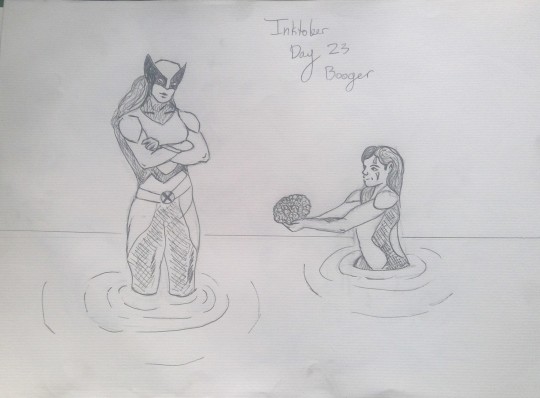
Inktober Day 23 -- Booger
A Dragon Booger (the weird blob that Gabby is holding) is a fresh water bryozoan found in California (thought to be invasive there), Vancouver’s Lost Lagoon, and east of the Mississippi River. Much like saltwater corals, the organism itself is incredibly small animals that live in colonies numbering in the thousands. Instead of a hard calcium carbonate shell, Dragon Boogers form these giant clumps of slimy moss-like balls.
I’ve always wondered what happens in comics when the ship/plane gets destroyed after a big fight and the heroes are waiting for pick-up. I know its probably not interesting enough for panel time and would congest the story, but what do they do? Do they just hang around? Are there snacks?
Here Gabby is off exploring the local lake, because waiting is boring. And she found a treasure to show Laura
5 notes
·
View notes
Text
Bryozoans: Nature's Water Filters
Bryozoans, often referred to as moss animals, are among the lesser-known inhabitants of aquatic ecosystems. Yet, their presence and diversity are crucial indicators of environmental health. This article delves into the fascinating world of bryozoans, shedding light on their ecological roles and how they help signal the well-being of aquatic habitats.
What Are Bryozoans?
Bryozoans are a phylum of small, colonial invertebrate animals that thrive in both freshwater and marine environments. These creatures form intricate, often beautiful colonies that can resemble moss, coral, or even delicate lacework. A colony comprises numerous individual units called zooids, which are clones functioning together for feeding, reproduction, and defense.
Ecological Significance of Bryozoans
Bryozoans are vital components of aquatic ecosystems. They play several key roles:
- Biofiltration: Bryozoans feed by filtering microscopic particles from the water, using a specialized structure known as a lophophore. This process of biofiltration contributes to clearer, cleaner water and aids in maintaining the balance of aquatic ecosystems.
- Habitat Formation: The complex structures of bryozoan colonies provide shelter and living spaces for a variety of other aquatic organisms, including fish, invertebrates, and microorganisms. This biodiversity supports healthy aquatic ecosystems by ensuring a balanced food web.
- Indicators of Water Quality: The presence and diversity of bryozoan colonies are indicators of water quality. Bryozoans are sensitive to pollution and changes in water chemistry, making them excellent biological markers for environmental scientists monitoring the health of aquatic ecosystems.
Bryozoans as Environmental Indicators
Bryozoans' sensitivity to pollution and environmental changes positions them as natural indicators of ecosystem health. A diverse and abundant bryozoan population typically signifies clean, oxygen-rich water, whereas their absence or decline can signal environmental degradation. Scientists study bryozoan species composition, distribution, and health as part of bioassessment programs to evaluate the impact of human activities on aquatic ecosystems.
The Role in Bioassessment and Conservation
Bioassessment programs often incorporate bryozoans to monitor and assess the health of aquatic environments. By tracking changes in bryozoan communities, researchers can identify impacts from pollution, habitat destruction, and climate change. This information is crucial for developing conservation strategies and mitigating adverse environmental impacts.
Challenges and Future Directions
Despite their importance, bryozoans remain underappreciated and understudied. Increasing public and scientific awareness of these creatures and their roles in ecosystem health is vital. Further research is needed to understand better the specific conditions bryozoans require and how they respond to various environmental stressors. Such knowledge will enhance our ability to use bryozoans as effective bioindicators and contribute to the conservation of aquatic habitats.
Bryozoans are more than just intriguing aquatic organisms; they are sentinels of environmental health. Their ability to filter water, support biodiversity, and indicate ecosystem changes makes them invaluable in our efforts to understand and protect aquatic environments. As we continue to uncover the secrets of these moss animals, we deepen our appreciation for the complex interdependencies that sustain life in our planet's waters. Recognizing and preserving bryozoans is not just about saving a fascinating group of animals—it's about ensuring the health and vitality of aquatic ecosystems worldwide.
Read the full article
1 note
·
View note
Text
So apparently it is ‘Fossil Friday’:) I like this term!
I cracked open that one from my last post and was rewarded with my favorite genus of Brachiopod, ✨ Leptaena ✨!! so beautiful..

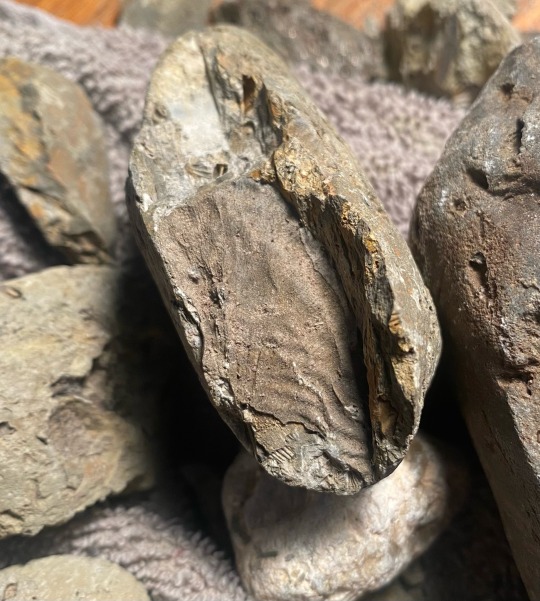
Also I cracked open this mush

I managed to weasel this lady out!!


I am honestly not too sure what I am looking at in the 2nd photo, I am 93% sure this is half of a Brachiopod, so I am guessing those are the innards, so I am also guessing that that circle is the pedical, maybe? It is just so large?. I have never found one with the inside visible like this. And I just can not find any references I need .. anybody know?
Also another Leptaena was also in there
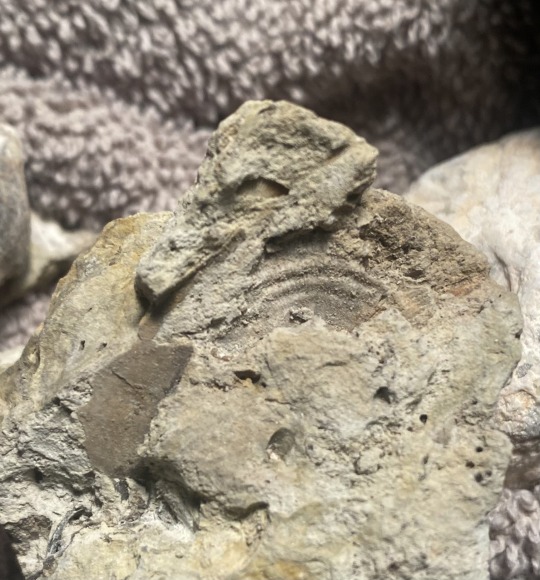
And an adorable Bryozoan sheet that makes me crave honey:)
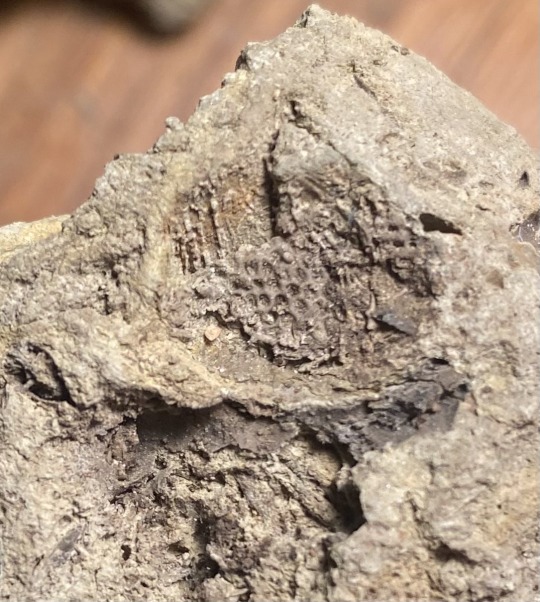
And here is a better photo of the chisel project I was working on the other day! I am a little stuck on this one, I really do not want to damage the Crinoid, it seems so fragile..

#fossil friday#devonian fossils#devonian period#my fossils#amateur paleontology#paleontology#fossils#fossil#fossil hunting#fossil collecting#geology#devonian#fossilblr#brachiopod#devonian fossil#brachiopods#bryozoan colony#bryozoa#bryozoans#bryozoan#crinoids#crinoid#rocks#rockblr#brachiopod fossils#earth science
10 notes
·
View notes
Text
On Creature Design
Artists and writers often don't realize the full range of variety that animals include. This leads to "aliens" that are a lot less alien than a lot of creatures on Earth.
Imagine that you are designing an imaginary animal to go on an alien planet in a fictional universe. We'll suppose for this example that your creature fits the Earth definition of "animal." What might this creature be like?
Here's just some of the traits that "animals" in fiction are usually assumed to have...that real animals often don't have:
The ability to move around: To be fair, most animals have a motile phase of their life cycle, but many animals, such as corals, (most) sponges, and (most) bryozoans, don't move as "adults."
Bilateral symmetry: that is, there's a left and a right side that mostly mirror each other. Humans are bilaterally symmetrical. But not all animals are. Take starfish for example. They have radial symmetry instead.
Either an herbivorous or a carnivorous lifestyle: The natural world...actually isn't divided into predators and prey. Don't forget the detritivores!
The ability to make that one specific roaring sound that every single alien and dinosaur makes in a movie: Animals make some WEIRD fucking sounds okay. Y'all ever heard a blue jay making its "swinging gate" impression?
Size comparable to horses, cattle, and humans: It's weird to think about, but humans are megafauna. We're enormous compared to most insects, worms, birds, and even rodents and bats, the largest groups of mammals. The "average" animal is closer to a bee than a human. A lot of sci-fi beasts and monsters are the size of a rhino, but try going outside on Earth—you'll encounter a thousand much smaller organisms before you find one that large. A planet that is otherwise "Earth-like" would probably be similar.
Individuality or "Individual" lifestyle and consciousness: Yes, yes, I know the "hive mind" is a trope, but it's often still assumed that "animals" are individual units independent from one another, where each "individual" has a complete set of all the organs and features it needs to survive. However, some real animals, like siphonophores and, yes, bryozoans, are colonial—their "individuals" are modules that can't live independently, rather like organs in an animal like a human. Because I can't stop myself from talking about bryozoans...in Selenaria bryozoans, the "individuals" around the outside edge of their colony use their setae as legs to walk around, and the other individuals provide the "legs" with food, since they can't eat by themselves. Bryozoan colonies are also interconnected by a linked nervous system, and sometimes colonies that grow into each other will just...merge, and start sharing their nervous system even though they're genetically different. Science.
Adaptations to full time life on land: Water worlds and sea creatures are not exactly missing in scifi, but it's still under-acknowledged that land life is a weird adaptation to a weird extreme environment. Land animals are just water animals that have learned to carry around their own water inside them. It's true! Living in water is so much simpler, because you can always just filter particles out of the water around you to eat, and when you need to reproduce you can just throw some gametes out there so somebody will find them.
"Male" and "female" individuals: Stories that mess with this generally have a MORE rigid biological "caste system" with more categories, but there are a lot of animals that can reproduce sexually or asexually at their whim, that change sex as part of their maturation process or when conditions require it, or that switch freely between producing sperm and egg cells. "The females are larger and more dominant!" isn't even that weird or unusual. Try "every member of this species is "male" when they are younger and becomes "female" later in life" or "this alien decides whether to be "male" or "female" depending on what the situation requires" or "these aliens are engaging in ritual combat with their dicks to see who gets pregnant." You know. Normal stuff like that.
3K notes
·
View notes
Text
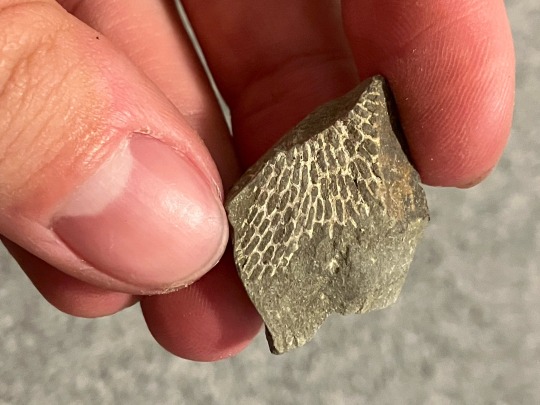
Fenestella fossil
Fenestella is a genus of now extinct moss animals known as Bryozoans.
They form fan shaped colonies with a netted appearance and were around from the middle Ordovician era to the early upper Triassic era with populations thought to be at their peak during the Carboniferous period.
The name Fenestella comes from Latin and means ‘little window’ in reference to the window like openings in the mesh skeletons of the colonies.
0 notes
Text
Cambrian fossil thought to be early bryozoan animal may actually be seaweed#Cambrian #fossil #thought #early #bryozoan #animal #seaweed
A fossil of a brachiopod shell, centre, with Protomelission attached to it, above, which was part of the new study
Zhang Xiguang
A 515-million-year-old fossil once thought to be the earliest known animal from a group called the bryozoans might actually be a seaweed.
Bryozoans, commonly called moss animals, are tiny, coral-like creatures that live in colonies in oceans and freshwater.
Nearly all…

View On WordPress
0 notes